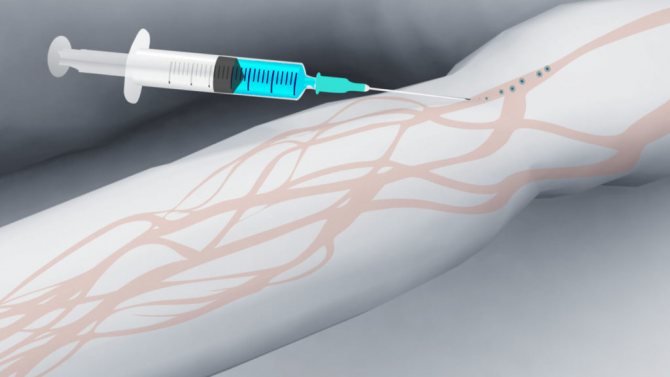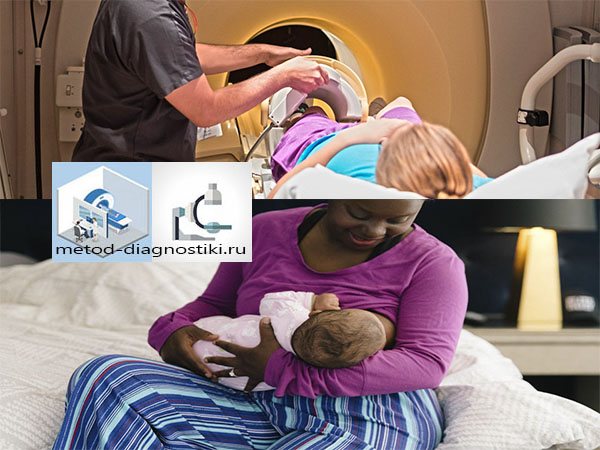Breastfeeding often lasts more than one month, and sometimes more than one year. At this time, no woman is immune from various diseases. In some cases, an accurate diagnosis can only be made using MRI. But it is believed that the contrast agent can harm mother and baby, and the procedure itself is not entirely safe. So breastfeeding women ask themselves the question: is it possible to perform an MRI while breastfeeding?
MRI, especially without contrast, is most likely permitted during breastfeeding after assessing the balance of benefit and potential harm for mother and child.
What is MRI
The essence of magnetic resonance imaging is that the signal most often scanned is from a hydrogen atom located in a magnetic field. At the same time, the influence of the electromagnetic field is completely harmless, which cannot be said about the influence of X-rays. In addition, the information obtained through MRI is very reliable and accurate. The safety of such diagnostics allows this method to occupy a leading position among other types of medical research. The advantages of tomography are obvious:
- this is a non-invasive method for examining the female breast;
- there is no risk to health (except for individual contraindications in exceptional cases);
- quick detection of the problem - there is no long and painful research into diseases or pathologies;
- accurate diagnosis;
- not only the detection of tumors, but also the analysis of the tumor - benign or not.
In today's medicine, when performing an MRI procedure, there are three ways to administer a contrast agent:
- The classic option is to administer the substance intravenously, and the diagnosis is carried out immediately after the injection, after 25 seconds.
- Bolus method - contrast agents are administered one after another, following the sequence and dosage using a catheter.
- Dynamic method - the procedure is carried out at a time when the administered contrast agents are in the body at maximum concentration.
When is MRI indicated?
During breastfeeding, women may be prescribed the procedure in several cases:
- abnormalities in the functioning of the pituitary gland;
- disturbances in the functioning of the nervous system;
- diseases related to the musculoskeletal system;
- suspicions of diseases associated with cerebral vessels;
- pathologies of the inner ear;
- lumps or tumors in the breast;
- research on the effectiveness of the chemotherapy course.
Both for an ordinary person and for a nursing woman or her child, MRI is completely safe, there is no risk to health or life. Therefore, if there is an unknown diagnosis and the absence of individual contraindications, this procedure is chosen as a diagnosis.
In some cases, women are allowed to have an MRI with contrast. For example, to clarify the nature of neoplasms in the mammary glands, diagnostics must be carried out with the introduction of a contrast agent. Many of them, as well as their impact on the health of the child and mother's milk, are still subject to criticism from medical professionals.
Pros and cons of the study
The advantages of this method include:
- Clear visibility of soft tissue. The introduction of contrast agents during MRI allows a clear assessment of the state of blood supply in all organs and tissues.
- There is no long and difficult preparatory stage before the study. The only point in preparation is the removal of all metal products from the body one day before the procedure.
- Safety of tomography. The main distinguishing feature of MRI is the complete absence of negative consequences for the body.
There are also a number of disadvantages that prevent the widespread use of magnetic resonance imaging. First of all, this:
- The procedure can only be carried out in a specially equipped room where there is no interference of any kind.
- The process of capturing the image takes about a minute, that is, if respiratory movements are recorded during this time, they can distort the reliable picture.
- Women with a pacemaker or any other metal implants will have to refuse such a study.
- MRI is not performed on patients with claustrophobia.
- The procedure is not intended for the study of functional disorders and autoimmune diseases.
MRI is an accurate and relatively safe way to diagnose diseases of the brain or gastrointestinal tract, including during breastfeeding.
Alternative Methods
There are no alternative methods to MRI, because only this study is safe and will allow you to determine why the mammary glands may swell or why headaches appear.
Computed tomography, often prescribed for sarcoidosis and many other disorders, is rarely used in such cases. This is explained by the fact that MSCT during breastfeeding carries harmful ionizing radiation that can accumulate in milk.
How do injected drugs affect the baby?
Based on the safety of the research procedure itself, the question of whether to perform MRI during breastfeeding or not arises due to the use of contrast agents in the diagnostic process. First, they penetrate the milk ducts, and from there into the milk, so doctors warn nursing mothers and advise using other examination methods. If there are no such analogues, then you should not feed your baby milk that could contain active drugs.
Otherwise, milk with excess active ingredients may cause the following symptoms:
- increased gas formation in the baby and bloating;
- sleep disturbances and increased excitability;
- intoxication.
If the baby is intolerant to some components of such substances, then the harmful effects only increase. Radiocontrast agents for MRI are administered in two types: water-soluble (mostly containing iodine) and insoluble (including gadolinium ions or barium sulfate).
When breastfeeding babies, women are prohibited from using iodine-containing medications. But when performing MRI (both of the head and other organs), substances containing iodine are almost not used, unlike CT. In addition, during this procedure, iodine molecules enter into a covalent bond with the main reagents, which is why there are practically no molecules observed in the free state.
Barium sulfate is also not considered dangerous for infants, because it is used for examining the gastrointestinal tract and does not pass into breast milk.

Modern contrast agents have a short lifetime and are safe to use for hepatitis B (with the exception of iodine-containing drugs).
Contrast agents based on gadolinium ions, whether gadopentetic acid or others, have a fairly fast half-life, only 1.5 hours. Having penetrated the body, they are eliminated in a very short time. For example, Magnevist is excreted 80% in the urine after 6 hours, and a small part of it ends up in milk - 0.04%. In such quantities, the substances are not capable of causing serious harm to the health of the newborn. However, there is an opinion that proper research into the effect of these ions on the children's body has not been carried out. Therefore, manufacturers of MRI machines recommend expressing milk after the procedure. It’s even better to do this several times, and for the next 24 hours feed the baby with the available supplies of mother’s milk.
Effect of drugs on a child
During the examination, the equipment takes layer-by-layer images, and after the MRI, the computer combines them into a single picture. In this three-dimensional image, the specialist sees the structural features of the organ being studied, cysts, tumors, etc.
As a result of MRI, the final “picture” is quite detailed. But in some cases, doctors prescribe diagnostics with contrast. This is a substance that is administered before the image through the mouth (when studying the digestive organs) or intravenously. It helps to flesh out the photo and make it clearer. In particular, when conducting MRI in gynecology, a contrast agent is used during breast examination to obtain a pronounced vascular pattern and outline the boundaries of possible tumors.

The injected substances used are preparations based on gadolinium, a rare earth metal with special magnetic properties. Its extremely low toxicity was noted in comparison with the same iodine-based contrasts that are used in other types of examinations. The only thing doctors warn patients about before an MRI with a contrast agent is the possibility of allergies. The phenomenon is quite rare, but cases have been recorded.
Since contrast agents enter the body during breastfeeding, women are interested in the question of whether a nursing mother can undergo tomography with the introduction of substances. Moreover, experts’ assessments on this matter vary.
When breastfeeding, most of the substances entering the bloodstream penetrate into the milk. This is how vitamins, microelements and other beneficial substances are delivered to infant food. However, contrast solutions injected into a woman’s blood during examination have a short half-life. This means that within 1-4 hours after administration, a larger amount appears in the urine. Researchers have attempted to find traces of gadolinium-based contrast agents in breast milk. Experiments have shown that only hundredths of a percent are detected, that is, an extremely insignificant amount.
Age up to one or two years is not a contraindication for MRI with contrast. That is, if doctors are able to ensure the patient’s immobility in the device, then even infants can be examined with this high-precision method. Consequently, even if substances administered to the mother end up in milk, they are dangerous only if the child is personally intolerant to these drugs. There is no need to suspend lactation during the examination.
Should I breastfeed my baby after an MRI?
There is the opinion of prominent experts in the field of pediatrics that it is not necessary to limit the baby to mother's milk after an MRI during lactation. According to them, if particles of substances penetrate into the baby’s milk, then in very minimal doses, which are not capable of causing harm even if the procedure is carried out during feeding itself.
The corresponding recommendations of manufacturers are associated with the reluctance to take responsibility in exceptional cases in the event of a baby’s personal intolerance to the components of these substances that come into contact with milk. This theory is also confirmed by the fact that magnetic resonance imaging can be prescribed for the baby himself, also with the introduction of a contrast agent. And its quantity is several times higher than the volumes that the baby receives from breast milk. And this procedure is also considered safe for a newborn.
That is, the mother herself must decide whether to undergo such a procedure or not, and only after consulting the treating pediatrician.
If the baby has no prerequisites for deterioration in health, then you should not stop breastfeeding. But if a child is susceptible to allergic reactions or has difficulties with intestinal function, then it is better to postpone feeding until later. And after the procedure, use pre-expressed milk.
In this case, it is worth expressing the breast after diagnosis so that this portion of milk does not reach the baby.
Contraindications for magnetic tomography during breastfeeding
Among all types of diagnostics during lactation, magnetic resonance scanning is preferred because it does not carry radiation load on the mother’s body and does not expose it to negative effects. However, computer diagnostics MRI during breastfeeding has certain contraindications:
- the presence of metal objects in a woman’s body - implants, pins, clamps, clips, prostheses, with the exception of titanium alloys;
- the presence in the body of life support devices for ventilation, an artificial kidney, an insulin pump;
- presence of electronic mechanisms, stimulators, defibrillator, hearing aid;
- chronic diseases in the acute stage;
- inability to hold oneself for some time without moving (convulsive syndromes, epilepsy);
- claustrophobia;
- When prescribing magnetic resonance imaging with the use of a contrast agent, an allergic reaction and individual intolerance to the contrast components will be a contraindication.

If an MRI with contrast is prescribed, then you first need to check the condition of the patient’s urinary system
In order for a woman with an implant to be allowed to undergo an MRI of the cervix or ovaries, she must obtain a certificate from the institution where the operation to insert the object into the body was performed. It must indicate the composition of the installed prosthesis, that is, what metals it is made of.
Before performing computer MRI diagnostics during breastfeeding, it is important to know the state of the nursing mother’s urinary system; it is dangerous to perform the procedure if its functions have not been impaired.
Contraindications
Like all other medical procedures, MRI has some contraindications. This diagnostic option is unacceptable for persons:
- having any metal implants;
- those suffering from diseases that may cause involuntary movements, as well as from claustrophobia;
- pregnant women up to 3 months.
Contrast studies are prohibited if there are signs of an allergy to the substance itself or if there are diseases of the genitourinary system.
That is, MRI cannot be prescribed to absolutely every patient, but only if his health condition allows it. It is also better for a nursing woman to notify her doctor about the presence of allergies in her baby. And at the slightest suspicion or concern, you should consult a therapist about similar research methods. But, as a rule, the procedure, including contrast, is completely safe for both mother and child, and in extreme cases, milk can always be expressed.
Absolute contraindications to the procedure
In addition to conditional contraindications to examination using a magnetic field, there are also absolute ones. Diagnostics for breastfeeding women is allowed, but first you need to study all the contraindications for the study:
- the presence of iron implants (they can distort the results of the study);
- insulin pump;
- installed pacemaker;
- renal failure;
- allergy to the contrast agent in the mother or child.
What pediatricians say
The opinion of most doctors is ambiguous. Thus, Jack Newman, a scientist from Canada, speaks of the complete safety of MRI during breastfeeding, believing that such diagnostics can only be slightly adjusted in case of allergies in the baby. After all, even when introducing contrast agents that do not harm the baby, they will disintegrate quite quickly.
Thomas Hale, an expert in the field of pharmaceuticals, argues that to the extent that the active substances penetrate the baby, they cannot adversely affect the baby's health. Moreover, you should not stop breastfeeding. This applies to absolutely all contrast agents - Magnevist, Dotarem, Gadovist or Omniscan. Many years of medical practice show that MRI with such drugs is safe for lactation and the health of the baby.

MRI is used even for children, and therefore the potential harm to the baby when performing such a procedure for a nursing mother is minimal.
The price of an MRI may also influence the decision to undergo the procedure. Before the study itself, a competent therapist will in any case warn the nursing mother about possible risks. Therefore, a woman should weigh the pros and cons and make the only right decision in favor of her child.











